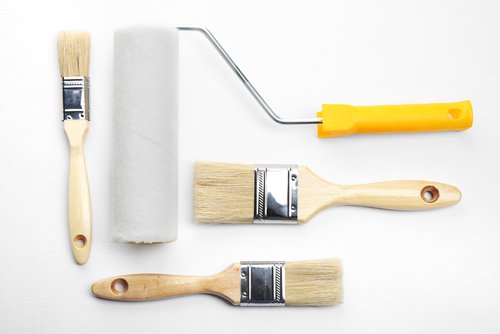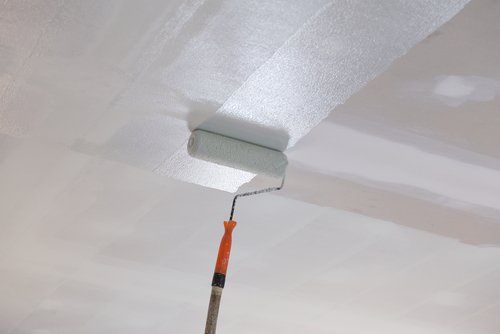Painting a ceiling may seem like a daunting task; however, with the right approach and some useful tips, you can achieve a professional-looking finish that would enhance the overall aesthetics of your space. Discover the step-by-step process of painting a ceiling, ensuring a successful and satisfying result.
See also: Ceiling paint colour ideas and trends in 2023
Step 1: Choose the right paint

Before you begin, it is essential to understand the different types of ceiling paints available and how to choose the most suitable one for your project. Ceiling paints come in various finishes, including matte, flat, satin and semi-gloss. The choice of finish depends on your preference and the room requirements. To determine the right paint for your ceiling, consider the lighting in the room and the overall colour scheme. For rooms with ample natural light, a flat or matte finish would reduce glare, while a satin or semi-gloss finish is more suitable for spaces with minimal lighting.
Step 2: Prepare the ceiling and room

Proper preparation is crucial for achieving a smooth and long-lasting paint job. Start by removing all the furniture pieces from the room to avoid splattering or damaging them. Cover immovable furniture with blankets and drop cloths. Prepare the ceiling by cleaning it to remove dust, dirt or grease. Repair cracks or imperfections with spackle and sand the surface to create a smooth canvas for the paint. Applying a primer is essential, especially if the ceiling has never been painted or has significant stains. The primer helps the paint adhere better and ensures an even finish. Allow the primer to dry before paint application.
Step 3: Gather your painting supplies

Having the right tools on hand can make the painting process more efficient. For painting a ceiling, you will need paint rollers and brushes suitable for ceilings as they often have longer handles to reach high areas. Drop cloths and painter’s tape will protect your floors and walls from accidental splatters. Depending on the ceiling height, a sturdy ladder or an extension pole for your roller would be necessary to access hard-to-reach areas.
Step 4: Start painting

Begin by cutting-in the edges of the ceiling using a paintbrush. Cutting-in involves painting a border along the edges of the ceiling where the roller cannot reach. This ensures a neat and precise finish. Once the edges are done, use a paint roller to cover the rest of the ceiling. Start in one corner and work your way across the room in small sections. Use long, even strokes to achieve consistent coverage. Be mindful of drips or runs and correct them promptly. To maintain a smooth finish, avoid overloading the roller with paint. Instead, apply moderate pressure and add more paint as needed. Work systematically and try to complete the ceiling in one session to avoid visible lap lines.
Step 5: Add a second coat

After the first coat is dry, inspect the ceiling for any missed spots or imperfections. Touch up these areas before proceeding with the second coat. Applying a second coat of paint ensures a more durable and vibrant finish.
Step 6: Cleaning up

Once you have finished painting, clean your paint brushes and rollers thoroughly with water or an appropriate solvent, depending on the paint type. Store them properly for future use. Dispose of leftover paint and empty paint cans following local waste disposal regulations.
FAQs
How long does it take to paint a ceiling?
The time it may take to paint a ceiling depends on its size and the number of coats required. Generally, it can take a few hours or a full day to complete the task.
Can I use regular wall paint on the ceiling?
While it is possible to use wall paint on the ceiling, ceiling paints are formulated to be spatter-resistant and have a specific finish suited for overhead applications.
Do I need to prime the ceiling before painting?
Priming the ceiling is highly recommended, especially if it is unpainted or has stains. A primer helps the paint adhere better and ensures a smoother finish.
What is the best time of day to paint a ceiling?
Choosing a time with good natural light can help you see imperfections and ensure even coverage. However, you can use artificial lighting to achieve similar results.
Can I paint a textured ceiling?
Yes, you can paint a textured ceiling. It may require a bit more effort but using a roller with a thicker nap can help cover the textured surface effectively.
| Got any questions or point of view on our article? We would love to hear from you. Write to our Editor-in-Chief Jhumur Ghosh at [email protected] |

Dhwani is a content management expert with over five years of professional experience. She has authored articles spanning diverse domains, including real estate, finance, business, health, taxation, education and more. Holding a Bachelor’s degree in Journalism and Mass Communication, Dhwani’s interests encompass reading and travelling. She is dedicated to staying updated on the latest real estate advancements in India.
Email: [email protected]











